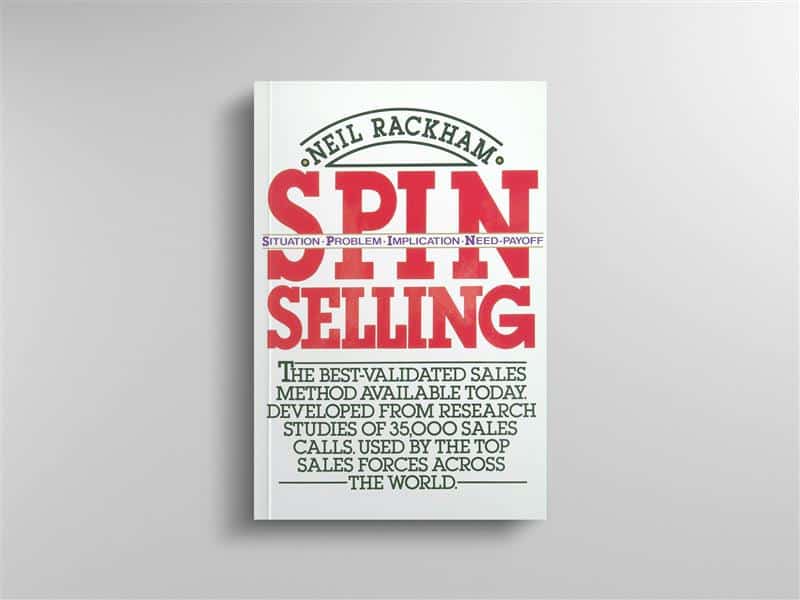“Sell me this pen.”
You won’t find cliché exercises like this in Neil Rackham’s career defining book. SPIN Selling is strictly for high-level sales professionals pursuing major sales—the kind of business opportunities with attractive margins and rewards.
If you’re involved in securing large projects or hefty contracts and want to improve your close rate, this book is a must.
The basic idea of SPIN Selling
The basic idea of SPIN Selling is this. The high-pressure closing tactics used in small sales don’t work on big ticket items. For example, traditional sales tactics stress things like
- Relating to the buyer’s personal interests
- Open vs. Closed questions
- Objection handling
- Giving benefits
- Closing techniques
According to Rackham’s research, these kinds of tactics are helpful for smaller sales but hurt the chances of winning a major sale. (Small sales refer to low dollar items that are sold in a single call, meeting or point of purchase.) Large sales are much bigger decisions, which means the salesperson must build perceived value to earn commitment.
Most larger sales, after they are made, require ongoing support. This means the buyer and seller will continue to meet after the dotted line is signed. As a result, the customer tends to view the product as part of the seller. They’re inseparable.

Put another way, the customer’s psychological needs are different in scope and kind when it comes to larger sales. Part of this is because the payoff for big purchase needs to be bigger. There is more risk.
After analyzing 35,000 sales calls over a 12-year period, Rackham and his research company, Huthwaite Inc., documented what exactly the best performing salespeople are doing: listening and asking questions.
SPIN questions
Common sense and research support the idea that the more questions you ask, the more successful the interaction is likely to be. However, one of the shocking findings in the book is the fact that there is no evidence that supports the idea that Open or Closed questions are linked to sales success.
Open questions require longer answers. Examples include “what does your business do?” or “how can I help you?” Closed questions can be answered with a single word like “yes” or “no.” An example would be something like “are you the person to contact for purchasing decisions at your company?”
Conventional wisdom says open questions are the most powerful. Unfortunately, the research says something different. In some cases, calls where the salesperson used closed questions were more successful. In most calls neither seemed to work.
Instead, the most successful questions follow a sequence or pattern Rackham coins as SPIN. SPIN is an acronym that identifies different kinds of questions. This becomes the heart of the book. Here’s the main idea of each.
Situation
Situation questions help the salesperson learn about the prospects’ current business practices and needs. It’s about gathering information. These can be either open or closed questions, depending on how much research the salesperson did beforehand.
It’s important to note that too many situation questions bore the prospect. Generally, avoid asking questions that can be answered on a prospect’s website. This can cut the data gathering time in half while still positioning the prospect as the expert in their field.
Problem
Problems start to rise from the prospect’s answers to the situation questions. The salesperson should be alert to any problems or hints to a problem. The next step is to explore those problems. This is more data gathering and letting the prospect speak.
You’re still asking questions in this section. Never assume you know the problem—let the prospect clearly define it themselves.
Implication
Implication questions may be the most complex questions to ask. The idea is to get the prospect to explain the negative effects of their problem. Examples of this might be “how will this problem affect your future profitability?” or “what effect does this response rate have on customer satisfaction?”
The book spends more time on crafting these kinds of questions than on any other. These questions should highlight the urgency of the prospect’s problem.

Need-payoff
Need-payoff questions are Rackham’s replacement for giving a string of benefits. The goal of asking these kinds of questions is to get the prospect to identify the benefits of your product or service themselves. It’s important that they feel like they discovered the solution to their problem. And you happen to be that solution.
These kinds of questions sound like this: “Would it be helpful if you had access to 24-hour support?” or “if we could speed up production by 15%, would that help you?” These kinds of questions have the strongest correlation to a successful sales call.
Applications for trade show booth staff
Generally, whoever is asking the questions is leading the conversation. This applies in real time in the exhibit hall. Booth staff attending large business-to-business shows would do well to study this book and practice asking questions on the show floor.
What’s the fastest way to learn about an attendees’ business situation? What problems do they have that you can solve? How quickly do their problems need solving? How much would they benefit from your products or services?
This post gives a 30,000 ft. view of SPIN Selling. At 192 pages, the book is well worth the investment in money and time.
The Trade Group is a full-service trade show and event marketing company. We will work with you to create an exhibit or an event that brings in leads and helps you achieve your business goals. Contact us here or give us a call at 972-734-8585.




